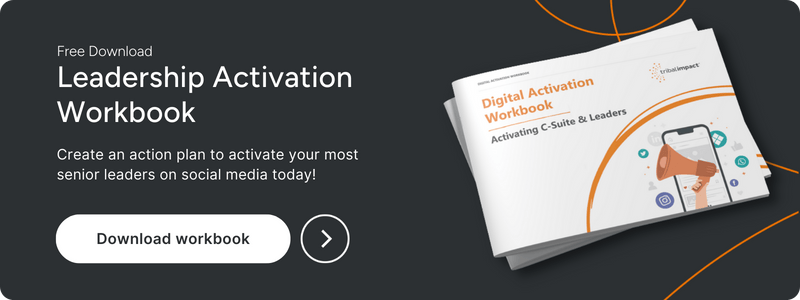Our weekly LinkedIn Lives series focuses on bringing together marketing, sales, and HR professionals to discuss their lessons in running employee activation programs on social media.
In one of our recent Lives, Sarah Goodall, Tribal Impact CEO, spoke to one of our customers - Aileen Scriba, Digital Communications Manager at Henkel, about how businesses can activate executives and leaders on LinkedIn.
You can listen to the podcast below, or read the key takeaways from the discussion in this blog.
It’s important leaders are active on social media (in fact, 68% of employees prefer to work for leaders who use digital and social media), but before they get to that stage, they need to understand the opportunities that social media – and LinkedIn in particular – can provide to the company.
Not every leader will want to be on social media, but they should support those who do choose to use it.
Start with the basics
A lot of leaders may think that social media is only for people who like to be in the spotlight, and that it’s all about discussing successes, projects, events, and conferences. In reality, it’s about building relationships with prospects, potential partners, and even future talent.
‘There’s a misconception that it’s all a broadcast platform,’ said Aileen. She went on to explain that the main objections she’s seen revolve around time, mindset, and knowledge. If one of these areas is lacking, a social media strategy won’t work.
Before someone can really embrace social media, they need to understand the mindset and skill set required to succeed.
Create a habit
Creating habits is an important part of someone’s enablement journey. Starting small, like with our Coffee Cup Routine, shows anyone new to social media how little time they need to get started.
Most of us already spend time on social platforms. Activating leaders means changing their habits so that they spend their time wisely, personalising their online presence rather than just aimlessly scrolling through their timeline.
For example, you could suggest checking the profiles of people who’ve checked their page. Tiny things like this that they might do anyway, but with a less conscious approach.
Sharing a passion for social
The more passionate someone is about social media, the better positioned they’ll be to convince leaders it’s not just another project they have to deliver at a certain time. Their passion will be contagious.
Many leaders are often held back because they think they need to share private information to create a personal connection with their audience. Being personal doesn’t mean sharing private information, though. Personal could be something from their personality, experiences, learnings, or leadership values.
Leaders need to understand social
After training, you don’t need to have every leader active on social media, but they do need to understand the impact social media can have. They also need to understand why their employees may be on social, and what impact it can have.
This is important because people who aren’t yet active may wonder why their employees, teams, or experts are posting about expert topics. It’s a whole new way of communicating that they need to wrap their heads around.
Leaders also need to learn to step out of their comfort zone and to encourage all employees to act as thought leaders. Training should include topics like managing reputational risks, what topics to talk about, and how to leverage their personal profile.
Training can also teach people how to optimise their account so that they see what they care about. By following the right people and hashtags, they can tailor their LinkedIn experience, instead of seeing irrelevant content in their feed and wondering why they’re not benefitting from LinkedIn.
Leaders should set an example
‘Employees – and future employees – expect accessible, transparent leadership,’ said Aileen. ‘They want to know they’re a part of a culture that’s forward-thinking, fast-moving, innovative. The expect to see leaders embracing this style of accessibility.’
Some leaders will be active on LinkedIn, happy writing long blog posts every week. Others are terrified at the prospect. It’s about recognising where their starting point is. Maybe it’s getting their profile optimised or liking some of their employees’ content.
As they gain confidence and competence, they can go up to the next stage, which could be sharing content or even creating their own. Be careful of accelerating people too fast, though – this might scare them off if they’re not ready yet.
Share stats and strategies
Sharing content strategies in leadership trainings will show leaders the benefits of LinkedIn. Most of them have never considered using a content strategy on there before.
Content buckets are helpful for creating a content strategy. This helps shift their mindsets, giving them a clear direction for what topics to post on. They all have their area of experience, or a passion for something like leadership or sustainability, or soft topics connected to their work.
Leaders may not post very often, or have a great LinkedIn profile, but they usually have broad networks. So, when they publish their first post, they get to see how many people engage with them. This can help them to reflect on the impact they have, something they may never have thought of before.
The flurry of engagement first posts get can encourage them to keep going, giving them evidence that social media works, and helping them to finally understand that it’s a way to communicate not just to customers, but to their teams too.
Conclusion
At the end of the day, employees follow the example of leaders within the business and look to them for guidance. They also go to leaders when they have questions. So, if leaders don’t understand why and how social media impacts the business, they can’t explain that to their team.
When they do have that understanding, even if they’re not active on social media themselves, they can also support other employees to become active on social media and become brand ambassadors themselves.
You can listen to the full interview on our B2B Social Growth Podcast.


